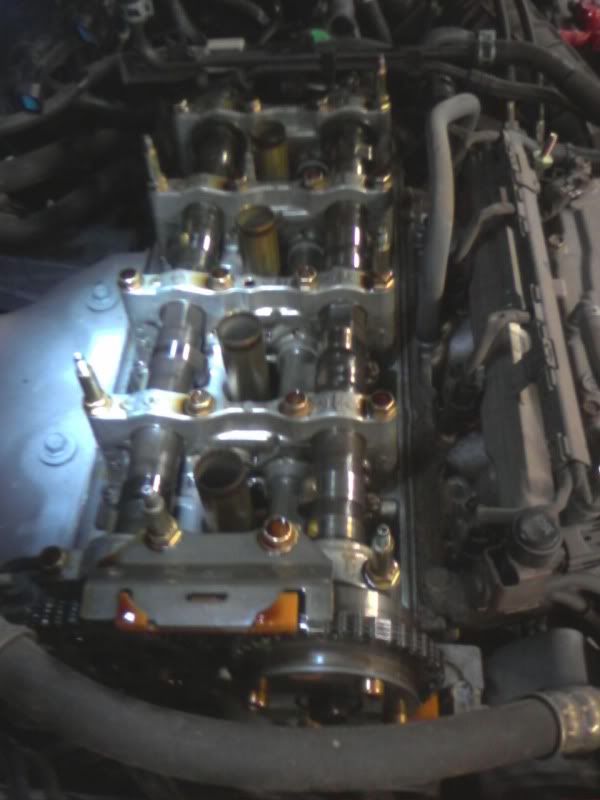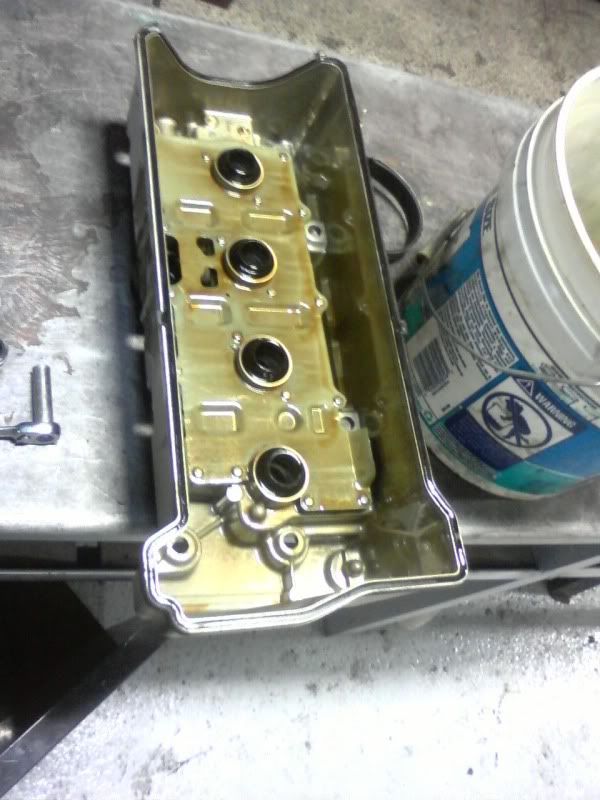I had some time to kill today. Classes are over for the semester. The wife is sick, and therefore no fun to be around. So I spent some time with the Accord.
If I remember right, the manual says to adjust the valves at 120k, but I've heard the occasional horror story about these K24 engines burning a valve if people waited that long to get the valves adjusted- although I think that mostly applies to the Element... heavier vehicle I guess. Anyway I figured now was a good time to get it done... and I also wanted to antiseize the plugs. I'm kinda paranoid about spark plugs in aluminum heads... known too many people to have problems with seized plugs.
The maintenance history of this vehicle is unknown. I got it at 85,000 miles. I've been running cheap dino oil in it, changing it at 5000 miles. I have about 3000 miles on the current oil. I'm happy to see that the innards are nice and clean:


The valves were definitely due for an adjustment. None were far enough out of adjustment to cause a real problem yet- but about half of the intake valves were too loose, and about half of the exhaust valves were too tight. Not the easiest valves to get to, but I guess I've dealt with worse. I used the same feeler gauges that I use on heavy truck engines- had to bend them a little to make them work.
I also pulled the plugs and had a look. Two of the four were NOT happy to come out. The threads were crunchy and binding, and they put up a bit of a fight. The other two weren't too bad. The plugs themselves looked fine. From what I've seen and read about irridium plugs, I expected that they would be ok. The threads in that aluminum head were my main concern... and seeings how money doesn't grow on trees, I just checked the old plugs over, put antiseize on them, and put the old plugs back in. The gap was still at .040", and there wasn't much wear on the electrodes. I expect that they'll be fine for at least another 50K. I have a Honda manual for this car (I've bought an OEM manual for the past three vehicles I've owned... a [censored] good investment IMO). And here's what Honda says about antiseize on plugs. I would have used it whether or not they recommend it, but it's nice to see that they have good sense about this sort of thing.

Overall I'm pretty impressed with this car. It's my first Japanese vehicle, and I had my doubts when buying it... but so far it's proven to be well-built and in some ways EASIER to work on than the GM's that I'm used to. Taking this valve cover off and adjusting the valves, every single bolt had a 10mm head. The engine was easy to turn over by using a ratchet on the p/s pump. The valve cover design and valve adjustment was really a LOT like the Detroit Diesel Series 60 engines that I work on regularly... just smaller of course. The timing marks were easy to find and align... nothing complicated about the procedure (unlike some shimmed cam followers that I've heard of). Granted, you don't have to adjust valves with a GM engine... but you don't have to worry about collapsed lifters with this Honda. I guess it's an ok trade-off.
If I remember right, the manual says to adjust the valves at 120k, but I've heard the occasional horror story about these K24 engines burning a valve if people waited that long to get the valves adjusted- although I think that mostly applies to the Element... heavier vehicle I guess. Anyway I figured now was a good time to get it done... and I also wanted to antiseize the plugs. I'm kinda paranoid about spark plugs in aluminum heads... known too many people to have problems with seized plugs.
The maintenance history of this vehicle is unknown. I got it at 85,000 miles. I've been running cheap dino oil in it, changing it at 5000 miles. I have about 3000 miles on the current oil. I'm happy to see that the innards are nice and clean:


The valves were definitely due for an adjustment. None were far enough out of adjustment to cause a real problem yet- but about half of the intake valves were too loose, and about half of the exhaust valves were too tight. Not the easiest valves to get to, but I guess I've dealt with worse. I used the same feeler gauges that I use on heavy truck engines- had to bend them a little to make them work.
I also pulled the plugs and had a look. Two of the four were NOT happy to come out. The threads were crunchy and binding, and they put up a bit of a fight. The other two weren't too bad. The plugs themselves looked fine. From what I've seen and read about irridium plugs, I expected that they would be ok. The threads in that aluminum head were my main concern... and seeings how money doesn't grow on trees, I just checked the old plugs over, put antiseize on them, and put the old plugs back in. The gap was still at .040", and there wasn't much wear on the electrodes. I expect that they'll be fine for at least another 50K. I have a Honda manual for this car (I've bought an OEM manual for the past three vehicles I've owned... a [censored] good investment IMO). And here's what Honda says about antiseize on plugs. I would have used it whether or not they recommend it, but it's nice to see that they have good sense about this sort of thing.

Overall I'm pretty impressed with this car. It's my first Japanese vehicle, and I had my doubts when buying it... but so far it's proven to be well-built and in some ways EASIER to work on than the GM's that I'm used to. Taking this valve cover off and adjusting the valves, every single bolt had a 10mm head. The engine was easy to turn over by using a ratchet on the p/s pump. The valve cover design and valve adjustment was really a LOT like the Detroit Diesel Series 60 engines that I work on regularly... just smaller of course. The timing marks were easy to find and align... nothing complicated about the procedure (unlike some shimmed cam followers that I've heard of). Granted, you don't have to adjust valves with a GM engine... but you don't have to worry about collapsed lifters with this Honda. I guess it's an ok trade-off.
